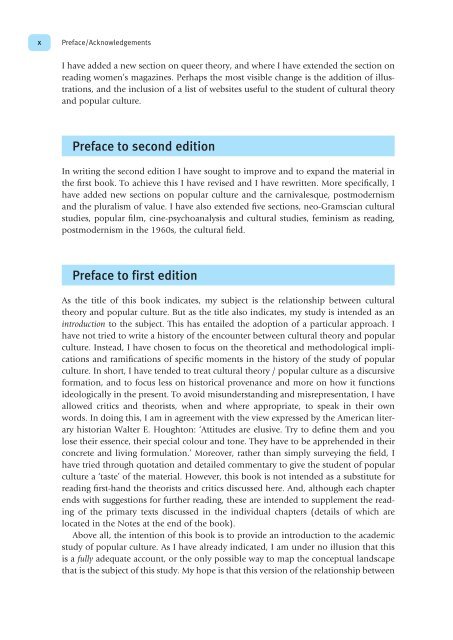Cultural Theory and Popular Culture
Cultural Theory and Popular Culture
Cultural Theory and Popular Culture
You also want an ePaper? Increase the reach of your titles
YUMPU automatically turns print PDFs into web optimized ePapers that Google loves.
x<br />
Preface/Acknowledgements<br />
I have added a new section on queer theory, <strong>and</strong> where I have extended the section on<br />
reading women’s magazines. Perhaps the most visible change is the addition of illustrations,<br />
<strong>and</strong> the inclusion of a list of websites useful to the student of cultural theory<br />
<strong>and</strong> popular culture.<br />
Preface to second edition<br />
In writing the second edition I have sought to improve <strong>and</strong> to exp<strong>and</strong> the material in<br />
the first book. To achieve this I have revised <strong>and</strong> I have rewritten. More specifically, I<br />
have added new sections on popular culture <strong>and</strong> the carnivalesque, postmodernism<br />
<strong>and</strong> the pluralism of value. I have also extended five sections, neo-Gramscian cultural<br />
studies, popular film, cine-psychoanalysis <strong>and</strong> cultural studies, feminism as reading,<br />
postmodernism in the 1960s, the cultural field.<br />
Preface to first edition<br />
As the title of this book indicates, my subject is the relationship between cultural<br />
theory <strong>and</strong> popular culture. But as the title also indicates, my study is intended as an<br />
introduction to the subject. This has entailed the adoption of a particular approach. I<br />
have not tried to write a history of the encounter between cultural theory <strong>and</strong> popular<br />
culture. Instead, I have chosen to focus on the theoretical <strong>and</strong> methodological implications<br />
<strong>and</strong> ramifications of specific moments in the history of the study of popular<br />
culture. In short, I have tended to treat cultural theory / popular culture as a discursive<br />
formation, <strong>and</strong> to focus less on historical provenance <strong>and</strong> more on how it functions<br />
ideologically in the present. To avoid misunderst<strong>and</strong>ing <strong>and</strong> misrepresentation, I have<br />
allowed critics <strong>and</strong> theorists, when <strong>and</strong> where appropriate, to speak in their own<br />
words. In doing this, I am in agreement with the view expressed by the American literary<br />
historian Walter E. Houghton: ‘Attitudes are elusive. Try to define them <strong>and</strong> you<br />
lose their essence, their special colour <strong>and</strong> tone. They have to be apprehended in their<br />
concrete <strong>and</strong> living formulation.’ Moreover, rather than simply surveying the field, I<br />
have tried through quotation <strong>and</strong> detailed commentary to give the student of popular<br />
culture a ‘taste’ of the material. However, this book is not intended as a substitute for<br />
reading first-h<strong>and</strong> the theorists <strong>and</strong> critics discussed here. And, although each chapter<br />
ends with suggestions for further reading, these are intended to supplement the reading<br />
of the primary texts discussed in the individual chapters (details of which are<br />
located in the Notes at the end of the book).<br />
Above all, the intention of this book is to provide an introduction to the academic<br />
study of popular culture. As I have already indicated, I am under no illusion that this<br />
is a fully adequate account, or the only possible way to map the conceptual l<strong>and</strong>scape<br />
that is the subject of this study. My hope is that this version of the relationship between
















